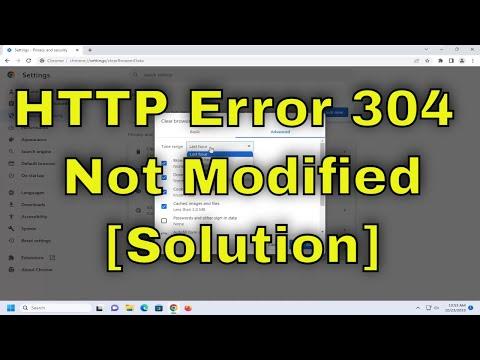To address the HTTP Error 304 Not Modified issue, it’s essential to understand that this status code indicates that the requested resource has not been modified since the last request. This is usually a good thing, as it means the server is optimizing performance by not sending redundant data. However, if this status code is causing issues, it’s crucial to delve into the potential reasons and solutions.
First, it’s important to recognize that HTTP 304 is a standard response used by web servers to inform the client (like a browser) that the requested resource has not changed, so there’s no need to reload it. This can be beneficial in terms of speeding up page load times and reducing server load. Despite its advantages, if your content is not being updated as expected, it may seem like a problem. Here’s how I resolved this issue.
My first step was to verify if the 304 response was the actual problem or if there were other issues at play. I examined my browser’s cache and server configurations to understand why the 304 status code was being sent. A common issue is that browsers or proxies might be caching old versions of files. To ensure I was working with the latest version, I cleared my browser cache and forced a refresh.
If clearing the cache did not resolve the problem, I investigated the server-side configurations. Web servers like Apache or Nginx often use cache headers to control how resources are cached. I checked the server settings to see if there were any cache-related headers such as `Last-Modified` or `ETag` that might be causing the 304 responses. These headers tell the browser whether the resource has changed since it was last fetched. Adjusting these headers or their associated settings often resolves issues related to stale content.
Next, I examined the response headers from my server to confirm if the 304 status was indeed being returned due to caching. Using browser developer tools, I looked at the network requests and response headers. This provided insight into whether the issue was with the server sending a 304 status or if the client was handling it incorrectly.
Another potential issue could be related to how content is served from a Content Delivery Network (CDN). CDNs cache content to improve load times and reduce server strain. If the CDN is serving outdated content, it might cause the 304 status to be incorrectly returned. I checked the CDN settings and purged the cache if necessary to ensure that fresh content was being served.
Updating the content itself is another approach. Sometimes, developers need to make sure that their versioning strategy for static assets is effective. By appending version numbers to filenames or using cache-busting techniques, it ensures that clients receive the latest version of the resource rather than relying on potentially outdated cached versions.
If the issue persisted despite these steps, I reviewed the application code to ensure that caching headers were being set correctly. In web applications, it’s common to encounter situations where caching logic is either overly aggressive or incorrectly implemented. Reviewing and correcting the logic responsible for setting headers can resolve problems related to content not being updated as expected.
In some cases, issues with HTTP 304 errors might also stem from third-party tools or plugins that manage caching. If you’re using such tools, ensure they are configured correctly and that they’re not interfering with the caching headers. Disabling or adjusting these tools can sometimes provide a quick resolution.
Testing with different browsers or devices can also help isolate the problem. If the 304 error is specific to one browser, it might be related to that browser’s caching behavior. Testing with multiple environments helps determine whether the issue is with the browser or the server configuration.
Ultimately, resolving HTTP 304 Not Modified errors involves understanding how caching is managed on both the server and client sides. By ensuring that cache settings are correct, clearing old caches, and verifying that the latest content is being served, you can effectively address and fix issues related to this status code. This process involves a combination of troubleshooting techniques, including examining server configurations, debugging application code, and managing cache settings effectively.
